|
|
By Jo Nova
Only two weeks ago a team of archeologists discovered an arrow made from a shell had survived 3,300 years in the ice in Norway. As the glaciers melt, the team has found some 4,000 items of clothes and hunting gear. Things that must have been precious to someone at the time — like hand-made leather bridles and Viking age knives — peeling away layers of history.
The director of the archeology team, Lars Holger Pilø, is very excited about finding a treasure trove of Early Bronze Age relics (as you would be). But he laments the cause — “the reason they are melting out is sad,” — he exclaims. The ice melt will lead to drastic changes in Norway’s landscape, he says, without seeming to notice he’s talking about warming the world back to what it was. Oh, the horror of a warmer climate that humans thrived in for thousands of years.
Today, some youngsters glue themselves to a road at the thought of another half a degree temperature rise, but imagine having to kill dinner with a shell strapped to a stick?
If only we could ask the last owner if they’d rather our current colder climate?
Maya Pontone, HyperAllergic
Archaeologists trekking through the Jotunheimen Mountains in Norway’s Innlandet County came across a remarkable find — an intact shell arrow dating back to the Early Bronze Age. Fastened with an arrowhead made of freshwater pearl mussel, the well-preserved hunting tool dates back 3,600 years and is one of eight shell arrows that have emerged from melting ice in Norway in recent years.
“The glaciers and ice patches are retreating and releasing artifacts that have been frozen in time by the ice,” Lars Holger Pilø, co-director of the archaeology program, told Hyperallergic.
It’s quaint the way they have to turn it into an ad for climate change, even though everything about this project screams “climate change is natural”
As global warming transforms Norway’s mountainous landscape, Finstad, Pilø and their fellow glacier archaeologists are rushing to collect the exposed artifacts, which continue to get older as the ice continues to melt.
There’s more photos at Secrets of the Ice. Archaeology is very cool, it’s just a shame when they have to talk about the climate religion.
Remember, none of the models can really explain why the Holocene was warmer than today, because CO2 was lower. It’s called “The Holocene temperature conundrum”.
Arrow heads shaped from shells by the sea,
Tied to shafts made of wood from a tree,
In the Bronze Age long ago,
When ‘carbon’ content was low,
And Norway’s green shores were ice free.
–Ruairi
h/t NetZeroWatch
9.9 out of 10 based on 91 ratings
By Jo Nova
WallStreetSilver has updated the great little pandemic musical on vaccine efficacy. Elon Musk retweeted it. So far 7.7 million people have seen it, 26,000 have commented and it keeps spreading.
Elon Musk replied:
My concern was more the outrageous demand that people *must* take the vaccine and multiple boosters to do anything at all. That was messed up. Until the Supreme Court invalidated Biden’s exec order, SpaceX and many other companies would have been forced to fire anyone who refused to get vaccinated! We would not have done so. I would rather go to prison than fire good people who didn’t want to be jabbed. As for myself, I got original Covid before the vaccine was out (mild cold symptoms) and had to get three vaccines for travel. The third shot almost sent me to hospital.
How many other people out there have symptoms that are actually from the vaccine or Covid treatment, rather than Covid itself? As for those who didn’t take any vaccine, well @DjokerNole just won a record number of grand slams … It’s not like I don’t believe in vaccines – I do. However, the cure cannot be potentially worse than the disease. And public debate over efficacy should not be shut down. There is also great potential for curing many diseases using synthetic mRNA, so let’s not throw the baby out with the bath water.
The music is ‘In The Hall of The Mountain King’, from the Peer Gynt Suite Op.46; No.1 by Edvard Grieg
h/t another ian, Colin A, Matthew L, GlennfromOz
Related information:
Keep reading →
9.6 out of 10 based on 77 ratings
9.1 out of 10 based on 9 ratings

By Jo Nova
For some reason wind and solar power will not be powering a new EV battery factory in Kansas. Instead the sudden extra demand for electricity will be met by keeping an old coal-fired plant running.
Environmentalists are not happy. Wait ’til they realize no one even knows if EV’s will reduce carbon dioxide at all.
Kevon Killough, Cowboy State Daily
A $4 billion Panasonic electric vehicle battery factory in De Soto, Kansas, will help satisfy the Biden administration’s efforts to get everyone into an EV. It also will help extend the life of a coal-fired power plant.
The Kansas City Star reports that the factory will require between 200 and 250 megawatts of electricity to operate. That’s roughly the amount of power needed for a small city.
Naturally, to make something utterly pointless takes a lot of taxpayer money and Panasonic will receive $6.8 billion from the Inflation Reduction Act, which will, quite possibly, increase emissions and create inflation too.
As Mark Mills said it takes 250 tons of material to make one EV. All that energy has to come from somewhere:
To match the energy stored in one pound of oil requires 15 pounds of lithium battery, which in turn entails digging up about 7,000 pounds of rock and dirt to get the minerals needed—lithium, graphite, copper, nickel, aluminum, zinc, neodymium, manganese, and so on. Thus, fabricating a typical, single half-ton EV battery requires mining and processing about 250 tons of materials.
It was all foreseeable. Europe, with more renewable energy, lost most factories for solar panels years ago, and is in the process of losing wind, batteries and EV’s. This week, Volkswagen cut EV production in Germany as demand “craters”.
ht/ John Connor II and RobB
EV photo by Vogler
9.8 out of 10 based on 79 ratings
8.6 out of 10 based on 15 ratings

Image by Ritu Rawat
By Jo Nova
It’s just another wake up call in the Green fairy fantasy land
It’s a nice idea to think we can store electricity in liquid fuels and effectively run our planes on wind or solar power, but the numbers are not your friend. The chief of Europe’s second largest airline presumably thought it was time to remind our planetary saviors that aviation really needs Avgas. There is no realistic option to decarbonize flights.
By Prarthana Prakash, Fortune
…while Lufthansa has tried to do its bit to adopt sustainable practices, the company’s chief says that switching the airline to green fuels like e-kerosene could come at a big price—half of Germany’s electricity supply.
“We would need around half of Germany’s electricity to create enough of the fuels,” Lufthansa’s Carsten Spohr said at an aviation conference Monday, Bloomberg reported. He added that while green fuels made using renewable energy sources would help Lufthansa decarbonize its fuel consumption, the likelihood of having enough electricity to produce such materials was low.
Essentially, to decarbonize Lufthansa about 30 million people would have to live in the dark. And we’re only talking of decarbonizing the flights, not the manufacturing of planes, runways and airports.
Carsten Spohr also pointed out that Lufthansa was “among the biggest buyers of sustainable aviation fuel (SAF)”, but there just wasn’t enough in existence, even if passengers were willing to pay for it.
“If the Lufthansa Group were to use all the SAF currently available, it would only be able to fly for just under two weeks.”
Only a few months ago, the experts announced that the lifespan of electric plane batteries was “only a few weeks” pouring more doom on the idea that planes can be “NetZero”. France announced that instead of short flights, people would have to catch the train (unless they owned a private jet, in which case it was fine).
Avgas is God’s gift to the masses.
9.8 out of 10 based on 92 ratings
8.7 out of 10 based on 15 ratings

Turtle Castle image by SAIF 4
Rishi Sunak’s delay in the NetZero Quest was the crack in the Uniparty Wall
Thanks to NetZeroWatch
It threatens to ignite a climate election. It matters, because now, suddenly, one party can point out the absurdities and the costs. They can be an Opposition, and mock the sacred cows. That doesn’t mean Sunak will do that, but the fork in the road has opened, the world is watching — and his party is suddenly up four points.
The Green funds cartel is “in shock” sayth Bloomberg, at the Sunak shift — so it must be pretty serious. Green investors are using the words “dismay” and “bewilderment”, which they almost never use. Green investment relies almost entirely on crowd psychology and government subsidies, so normally bad news is padded and fluffed so it doesn’t look so bad. We wouldn’t want to lose momentum would we? Boy are they losing momentum.
Meanwhile Sweden has not only cut climate money a bit, it’s unshackled some taxes off fossil fuels as well, leaving the centre left apoplectic and threatening to move motions of no-confidence. It is unthinkable, apparently, but Sweden might even increase emissions.
Germany has suspended draconian building efficiency standards and stepped back from their full gas boiler ban. They had wanted to ban all new “fossil” heaters from 2024, but after fierce protests, have instead brought in a much diluted and delayed version due to be adopted in 2028. President Emmanuel Macron must have been watching the German and British debacles. His new plan rules out a complete ban on gas boilers, and talks about protecting vulnerable people in rural areas, and even how the French love their cars.
What’s more scary than climate change? — The rise of the far-right
The quote of the day is from a German politician who sums up the major driver of these policy shifts.
Earlier this month, German Finance Minister Christian Lindner told Politico that stricter energy efficiency rules for buildings could fuel the rise of the far-right, amid growing apathy across Europe over plans to reach net zero.
— CleanEnergyWire
So Climate Change might cause the sixth mass extinction of life on Earth, but nothing is more frightening than the possibility of the far-left losing power at elections.*
Polls have leapt for the conservative government in the UK since Rishi Sunak slowed the NetZero train
This is what all the Climate-believer politicians are afraid of. Deep down, they know the NetZero quest is not popular with the masses, even though they say it is all the time. If they thought climate policies were really winners with the workers, they wouldn’t be so afraid of their opponents catching the skeptical train would they? Instead, they are aghast when their opponents dare suggest other priorities might be higher than changing the weather.
Express, UK
Deltapoll polled people from the 22nd to 25th, and saw a four point swing from Labour to the Tories compared to their last poll 10 days ago. Labour are down three points, with Mr Sunak’s party rising five points. While Labour is still ahead of the Tories by 16 points, this is a significant swing in a short amount of time.
The poll was of 1,507 adults from Great Britain…
This is a very good sign. Financial types almost never speak unguarded, out loud, lest they scare the horses. This is panic:
Some of the world’s biggest green investors are voicing dismay and bewilderment as they struggle to digest the UK government’s stated intention to wind back key climate commitments.
“It was a complete shock,” said Ian Simm, founder and chief executive of London-based Impax Asset Management Group Plc, a low-carbon fund investor overseeing close to $50 billion in assets. Britain’s official policy now represents “a risk for anyone considering an investment in the UK that’s dependent on government policy,” he said.
Investments in “government policy” are always riskier compared to investments in essential goods and services. They’re shaking, because the magic spell has broken. The cash cow might evaporate.
Unthinkable — Sweden has not only cut funding to climate action but cut the taxes on fossil fuels too:
by Miranda Bryant, The Guardian
Sweden’s government has come under criticism after unveiling a budget that will dramatically increase carbon emissions.
The budget, unveiled on Wednesday morning, includes a 259m krona (£19m) reduction in funding for climate and environmental measures next year, and tax cuts on petrol and diesel.
Rickard Nordin, the climate and energy spokesperson for the opposition Centre party, condemned the climate cuts, which he said were unprecedented.
“What has happened is that the Swedish government is consciously increasing emissions,” he said. “No Swedish government in modern times has consciously increased emissions. Few countries in the world have done that and it’s extremely serious.”
Amazing he could say it with a straight face — few countries have consciously increased emissions, he says, as if China and India don’t exist.
Macron is changing his tune too:
“We will not prohibit” the installation of new gas boilers, he said, “because we cannot leave our compatriots, particularly in the most rural areas, without a solution,” said Mr Macron.
Mr Sunak pushed back the ban on purchases of new gas boilers to 2035.
The French “love their car, and I do too” said Mr Macron on Sunday in a prime-time TV interview, acknowledging public reluctance to switch to electric vehicles with higher purchase prices than combustion-engine cars.
So many key words repeated in so many countries at the same time.
*We breathe a sigh of relief that some elections still matter. This is good news.
10 out of 10 based on 98 ratings
8 out of 10 based on 16 ratings
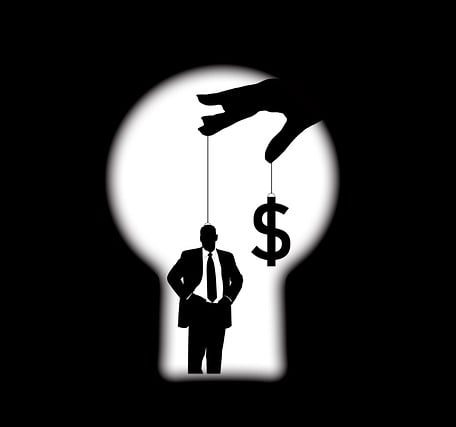
By Jo Nova
Unguarded Big-Money works like acid against democracy
Just like everywhere in the West, the money Australian’s earn may be quietly used against them to push policies they don’t want. The Australian Retirement Trust (ART) and HESTA are using their voting rights on corporate boards to push for climate action and gender diversity. They aren’t polling their members to find out if this is what they want. They are just following The BlackRock and GFANZ banker cartel modus operandi. It is coercion, done with the illusion of “good intentions”, but in reality, aggressively self-serving behaviour. The management of HESTA and ART couldn’t care less what the owners of the money want.
ART is a $260 billion fund (Australia’s second largest) with 2.2 million members. HESTA is a $76 billion fund with nearly 1 million members who are mostly working in health and community service. Just as with the US Funds, there surely is a question of fiduciary duty. Are these funds maximizing the return for investors or are they using their money to achieve political ends that result in lower income for retirees? Environmental investors lost 22% last year when energy investors made 54%.
So for directors on a corporate board, what’s the best way to hold off the climate police and the femo-activists from voting you out? You must publicly endorse “Net Zero” and women’s rights, even if you think they are witchcraft, against the company’s interests, bad for the nation, and bad for women. Imagine what happens to board members if they dare speak their mind?
The Paris Agreement, remember, appeared to be nearly worthless at the time, yet here it is years later, being foisted in reality in corporate boardrooms. A more detailed look at boardroom politics finds that global giants BlackRock and Vanguard are voting against Australian company directors that don’t serve the multinational globalist agenda.
We all know exactly how much BlackRock and Vanguard care about Australian jobs or the energy bills Australians are paying.
This is how the wheels of evil grind:
Super fund ART plans to pressure companies to slash emissions and sets a new net-zero road map
By Paulina Duran, The Australian
Australian Retirement Trust has committed to pressuring 88 companies to slash their carbon footprint, setting a new “net zero” road map to cut emissions in its portfolio of equities, infrastructure and real estate investments by 43 per cent by 2030.
Australia’s second-largest super fund said that it would start voting on all climate-related shareholder proposals in the Australian market and would link the remuneration of its own investment team to climate change performance.
HESTA to use voting rights to push for climate action, gender diversity and decent work
By Paulina Duran, The Australian
Super fund HESTA has warned the largest listed companies it intends to vote against male directors of boards with low female representation. In letters sent last week to the chairs and chief executives of the largest 292 ASX-listed companies it invests in, the $76bn fund said it would seek to engage on four “active ownership themes” ahead of the upcoming annual general meeting season. This includes influencing corporate policies on climate, “decent work” and biodiversity loss.
Thus HESTA are the climate police:
HESTA is also asking executives and board directors to work towards a goal of halving greenhouse gas emissions by 2030 and achieving net zero greenhouse gas emissions by 2050, in line with the goals of the Paris Agreement.
It wants ASX300 companies to accelerate investment in the electrification and decarbonisation of the economy, and its voting at this year’s AGMs will “consider progress in these areas and whether board skills and composition demonstrate preparedness for the low carbon transition,” it said.
This is a rapidly accelerating phenomenon in Australia
Super funds are getting bigger, thanks to Big-Government forced rules taking even more from the workers and handing their money to the control of small management boards that hardly anyone pays attention too. These toxic funds are increasing their ownership and influence and using their voting rights more often:
By Matt Bell, The Australian
Companies are under increasing pressure to consider the views of super funds, which held assets worth $3.5 trillion as of March. And funds are getting bigger with the compulsory super guarantee rate set to reach 12 per cent in 2025, up from 9.5 per cent in 2020.
Super funds’ ownership of the 10 largest companies listed on the ASX has more than doubled in the past 12 months to $60bn.
Super funds now own 6.3 per cent of Woodside, compared to 0.5 per cent in September 2022, with investments surging after a rally in global oil prices. Ownership of BHP, CSL, Wesfarmers and Westpac has almost doubled.
“It’s become more and more common for super funds and fund managers to use their votes at AGMs as an opportunity for investors to promote good governance and to endorse the actions of companies … or express concern over poor practices.
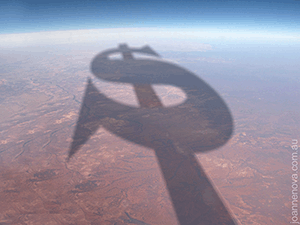
There are $3.5 trillion dollars unguarded in Australian Super funds
For Australians wondering where their money would be safe, the answer is not obvious. They may not even realize their funds are held with ART, which was only formed a year ago from the combination of Sunsuper and QSuper and the Australia Post Superannuation Scheme (APSS). The Chairman used to be a Labor politician in Queensland.
The news is not all bad. The largest fund in Australia — called AustralianSuper — was accused two weeks ago of protecting a Woodside board member that climate activists wanted to get rid of. The Guardian was unhappy:
Australia’s biggest superannuation fund helped Woodside Energy fend off a shareholder revolt over its climate policies, nullifying concerns raised by global investors, according to new analysis.
Activist group Market Forces said AustralianSuper recently voted for the re-election of Ian Macfarlane, a senior Woodside director and longtime sustainability committee member at the oil and gas giant.

The activist group noted the money pushing to get rid of Macfarlane included votes from BlackRock and Vanguard:
Market Forces said it paired its investment analysis with share voting data to identify how large shareholders voted. It found that major global investor BlackRock voted against the re-election of Macfarlane, as did several funds run by investment manager Vanguard.
So when Australian corporations or “The Business Council of Australia” speak about climate action, womens rights or Voting Yes for racist voices, (HESTA was the first fund to do so) they may merely be doing the bidding of foreign banker cartels. Who knows?
So if your retirements funds are in a politically toxic fund, where can you move them?
Even though AustralianSuper appears better than ART or HESTA, bear in mind that until March it had a large climate report and “Net Zero” factsheet on its website. It apparently deleted them (like many other funds) once regulators started promising to check whether funds green claims were really correct. Maybe that’s a good sign, but we could all hope to find a retirement fund that cares about our actual retirement first and foremost.
If readers want to help it would be very useful to compile a list of Australian Super Funds that had outspoken Woke policies (so we can avoid them) and a counter list that don’t play political games with your money. Naively, the climate activist group called Market Forces, and the Australian Conservation Foundation have done some work, but they are the financial simpletons that think investors just need to pull money out of fossil fuels and put it into renewable wizard magic to change the world. They don’t seem to realize that selling out is an old hat one-off protest. Activist funds now realize they have more influence by buying up shares and threatening to vote out Directors in order to change the corporate culture and sabotage companies from within.
We need those lists!
*For foreign readers, Australian pension accounts are called “Superannuation Funds”, like US 401k accounts.
Puppet image by Gerd Altmann, and cogs image by Pavlo and BlackRock photo by Jim.henderson
10 out of 10 based on 81 ratings
7.8 out of 10 based on 22 ratings
8.8 out of 10 based on 13 ratings
 Climate Justice looks a bit like a criminal phishing campaign. By Jo Nova
Malware to save the planet eh?
The Australian Youth Climate Coalition (AYCC) is asking supporters to send deceptive links out to friends and family that look like a cookie recipe but embed software cookies instead on the victim’s computer. The digital cookie then pushes green climate videos into their feeds, (as if the ABC news wasn’t loaded enough).
Look out for any links to oneminutecookie.com.
The AYCC gets about $3m in donations, and even visits schools, teaching children how to cheat and lie to save the planet, or something like that. What are good family relationships built on after all, if not deception? What is science if it is not propaganda?
These are all good questions to raise with the children in your life and the schools in your area. Don’t wait for an email to arrive, thank the AYCC for providing the opportunity to start the conversation now.
If the believers are so caring, ethical and moral why are they teaching children it’s OK to deceive family members? Is this the kind of “fair and just” world we want to live in?
Call up schools and the local P&C and ask if they are aware the AYCC — which runs programs in schools — teaches children to fool parents and grandparents and use malware. Are these the kind of family values that belong in our schools? Will the local school guarantee that they will not allow this group to manipulate children?
The Australian exposed their crooked game this week, and traffic to oneminutecookies.com has fallen to zero. So presumably the link trap will change. (The campaign has been put on hold).
Reporter Joseph Lam spoke to cyber security experts at Check Point Research:
The company’s tech evangelist Ashwin Ram, one of Australia’s top 100 Innovators, said the technique was not common but was something he imagined cyber criminals would use as part of phishing campaigns.
Mr Ram said cookies were used to “enhance the user experience”, but in the case of AYCC campaign, “it looks like the goal here was to lure sceptics of climate change to oneminutecookie.com”. He adds: “While the site looks innocent, a victim’s browser will store cookies that will affect their browsing experience by displaying content to support a particular narrative.”
If the evidence for climate change is so overwhelming, why don’t they use that to win friends and influence people instead of phishing tricks that criminals might use?


The best lesson children can learn today is that fascists and communists have always taught children to lie. It’s a means to an end. Read the confessions of a Red Guard — “I have led a life haunted by guilt”. Raised fists might not be the symbol that lifts you.
Image by …Rafaelgr
10 out of 10 based on 104 ratings
8.9 out of 10 based on 10 ratings

By Jo Nova
The UN is morphing into the New World Eco-Cathedral and the first commandment is “Give Us Your Money”
Antonio Guterres opened the Working Group Chapter on Fire and Brimstone and dug deep:
[AP News] “Humanity has opened the gates to hell,” U.N. Secretary-General António Guterres said Wednesday, opening a special climate ambition summit with yet another plea for action. “ Horrendous heat is having horrendous effects. Distraught farmers watching crops carried away by floods. Sweltering temperatures spawning disease. And thousands fleeing in fear as historic fires rage.”
In a reversion to the medieval era of microbiology, apparently heat itself spawns disease from the ether. We know heat is the devil itself, the source of all evil, as the IPCC has not found one single good thing that might happen with more hotness.
No one is even pretending this is science anymore, are they?
Once equilibrium climate sensitivity is at the Gates of Hell level, where can it go next? Magma level? And is that better or worse?
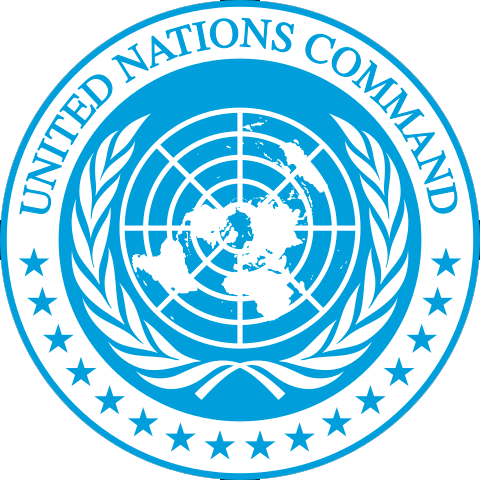 The developed world was put in the naughty corner, and not allowed to speak, so they didn’t turn up, or perhaps it was the other way around. The developed world was put in the naughty corner, and not allowed to speak, so they didn’t turn up, or perhaps it was the other way around.
Those [major emitting] nations remained silent. They weren’t allowed to speak because, organizers said, they had no new actions to take.
Heads of state from China, the United States, India, Russia, the United Kingdom and France all skipped the summit.
The 32 national leaders who did qualify represent only 11% of the world’s carbon dioxide pollution.
Guterres was apparently performing for a different crowd — whipping up the poor brethren nations to ask God for money, or failing that, the European Commission, or John Kerry which is nearly the same thing.
Guterres called on “major emitters — who have benefited most from fossil fuels — to make extra efforts to cut emissions, and on wealthy countries to support emerging economies to do so.” They were silent.
There’s some ceremonial ritual at work here, where rich nations are banned from talking then blamed for not saying anything.
Ultimately, the main point of the summit was to feed from the trough:
He called on wealthy nations to fulfill their $100 billion pledges to help poorer countries deal with climate change. The United States is one of the countries that hasn’t done so. The U.N. chief also pushed for countries to spend even more than they’ve promised and put in money to a “loss and damage” fund agreed upon last year that are sort of payments to help nations harmed by extreme weather from global warming.
There was a call to the promised land:
Africa “can leapfrog into a fully green industrial paradigm,’’ Kenyan President William Ruto said. “Yet we cannot and must not do this on our own.”
Little does the Kenyan President know that if Kenya gets there, to the green industrial paradigm, they will be on their own, because no one else has made it. The promised land doesn’t exist. The Green Industrial Paradigm is a the place where modern economies go to die.
Photos from David Neuvere and the EU mixed by Jo Nova, and UN logo by Sshu94
10 out of 10 based on 102 ratings
8.9 out of 10 based on 14 ratings
 Prime Minister Rishi Sunak By Jo Nova
Was this the “Peak NetZero” moment for the British Isles?
Perhaps the threat of jailing people for owning the wrong fridge was a step too far?
On Monday the UK government was insisting the ban on petrol cars by 2030 would still go ahead. Today, in a rush, it’s been delayed 5 years, along with slowing down the forced push to get rid of gas boilers. About a fifth of all householders apparently won’t ever have to buy a wildly expensive heat pump they could not afford. (Shame the other four fifths will). People won’t be getting seven different recycling bins, taxes on meat, flying and new rules on car sharing, at least not yet. Here’s hoping they’ll get delayed forever.
Naturally the PM is insisting this is “not a short term decision aimed at winning the next election” — because in a democracy, that would be a terrible thing, right. Imagine trying to appeal to voters. The Sin of it!
Labor immediately promised to undo this travesty of allowing the public to choose whatever kind of car they want for another five years. Which is good news. If Rishi Sunak really does this, and the election becomes “a climate vote”, the people of the UK might get a choice.
We know this is step in the right direction because Al Gore, Greenpeace and the Grantham institute people have already said they don’t like it.
h/t MrGrimNasty, and NetZeroWatch
PM waters down ban on gas boilers and petrol and diesel cars, scraps plans for seven bins per home and says there will be no extra tax on flights or meat
The Prime Minister hosted a Downing Street press conference to confirm plans to delay a ban on new petrol and diesel car sales by five years to 2035. And about a fifth of all households will be covered by an ‘exemption’ from ever having to remove their gas boiler and replace it with a heat pump.
‘We are not going to save the planet by bankrupting the British people.’
— Home Secretary Suella Braverman, Sky News
NetZeroWatch welcomes this and points out it was inevitable given the retreat in other nations and the impossibility of it all:
Net Zero Watch has long warned that current Net Zero plans are astronomically costly, technologically impossible and politically unsustainable. As European governments have begun to retreat from their own Net Zero plans, it was just a question of time before the UK, which has even more utopian targets, had to make a U-turn, and return to the path of economic and technological realism.
A few small truths come out…
Sydney Morning Herald
Sunak, who said governments “of all stripes” had not been “honest with the public” about the costs of net-zero…
He said the debate around climate change had been charged with “too much emotion and not enough clarity” and that the approach should shift to “consent, not imposition, honesty not obfuscation, pragmatism not ideology.”
“If we continue down this path, we risk losing the consent of the British people and the resulting backlash would not just be against specific policies, but against the wider mission itself,” he said.
What consent do they risk losing? The fake one created with ambiguous polls, loaded questions and by calling people “deniers”?
10 out of 10 based on 106 ratings
8.9 out of 10 based on 12 ratings
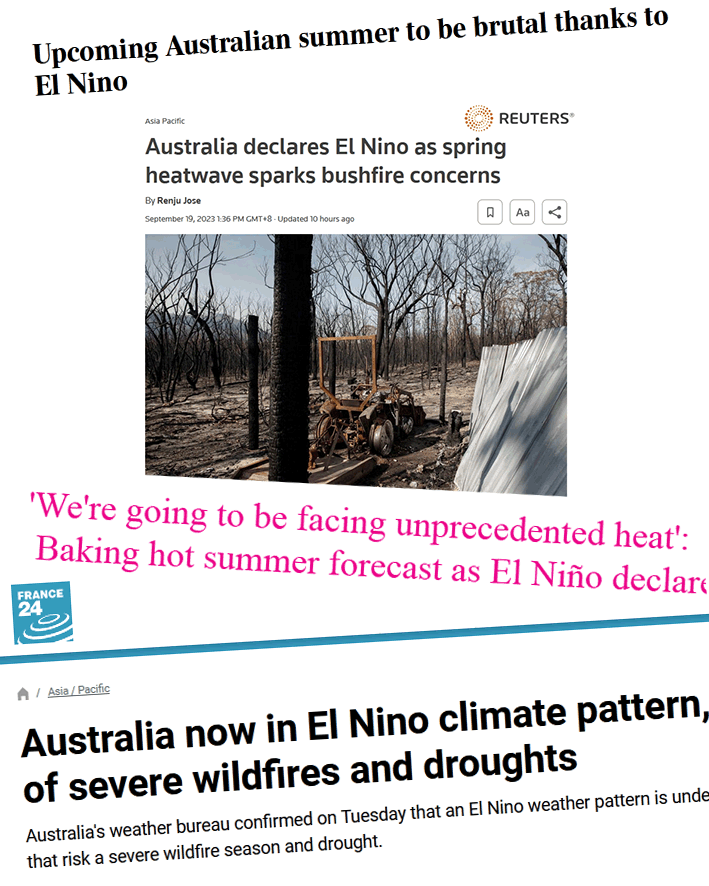
By Jo Nova
It’s like the bushfires and baking heat are already here (in your mind, if not in reality)
It’s as if we’re preparing for Pearl Harbour or something — and if you are not scared, you should be, and even if this summer isn’t that unprecedented, you will feel like it is, and if the hellfire doesn’t eventuate, there’ll be no headlines saying “Oops. We panicked for nothing!”
After 150 years of Pacific Oscillation, the Pacific has oscillated again. An El Nino has been declared, and like the last 27 El Ninos since Federation, it will probably be warmer and drier “than average” in Australia. But the Merchants of Panic are already calling it a summer of severe wildfires and droughts. There’s no flames yet, but Reuters is wheeling out the photos of burnt out wrecks. SBS found experts to badger us into making a “heat wave plan” — like seriously, as if Australians need three months to remember what summer is. No really — The Executive Director of Sweltering Cities (whatever that is), says you should buy up those extra ice cube trays now and learn the signs of heat exhaustion. Prepare your home — like what, find the air conditioner remote?
Even in France, apparently the risk of an Australian bushfire and drought that might, maybe potentially happen is now worth a headline. See how this works? Even if the world were cooling, there’s always someplace that might have a hot summer coming, and when all the world shares headlines of hellfire, people will feel like climate hell is truly here, even if the weather was just exactly what it has always been.
For perspective, here are the last 147 years of Pacific variation, just so people can appreciate how extraordinary this isn’t. This is a BOM graph, made by an agency that gets a million dollars a day from Australians to understand our climate, but somehow our billion dollar public news agencies can’t find it, and the BOM forgot to mention it in the press release.
It’s just another day in the land of droughts and flooding rains:
What matters is that the Pacific Decadal Oscillation is the largest short term driver of Earth’s climate, and we have no idea what makes it tick; we can’t predict it more than a few months in advance, and we have no clue at all about what it will do this time next year. (If we did, the BoM could tell our farmers useful things, like what kind of rainfall they’ll get before they put the seed in. )
Hidden in the small print on the ABC site, but not mentioned on the nightly news, is that El Nino’s don’t always create widespread drought, and that the models are sometimes wrong, and the slow development of this years event “might limit its strength”.
How to manufacture climate anxiety
SBS News really takes the cake today. The new normal is a world where you practically need a roster on the fridge to plan who does the 3pm check to see if Nana had her glass of water.
The Executive Director of Sweltering Cities, Emma Bacon, says people should have a heat wave plan.
“That means looking at our homes now and saying ‘how can I make it easier to keep cool inside? Do I need to get an extra fan? Do I need to get more ice cube trays? How can I block the heat from entering the house with extra awnings or things like that. So that’s one of the big things. it’s familiarising ourselves with the symptoms of heat exhaustion and heat stroke to make sure if we need medical care, then we know when that needs to happen. And what we also can do is we can figure out who we’re going to check in on during a heatwave that could be a colleague, it could be grandma, it could be you know a family member who’s pregnant, you know, people who might be suffering in the heat, who we are going to check in on and let’s make a plan to do that because community connection is one of the best ways to keep safe during a heatwave.”
It’s almost like prepping for a summer blackout without saying the word “blackout”? But, silly me, in the Renewable Crash Test Zone, being NetZero or living in a blackout are nearly the same thing.
9.9 out of 10 based on 122 ratings
8.8 out of 10 based on 19 ratings
|
JoNova A science presenter, writer, speaker & former TV host; author of The Skeptic's Handbook (over 200,000 copies distributed & available in 15 languages).

Jo appreciates your support to help her keep doing what she does. This blog is funded by donations. Thanks!


 Follow Jo's Tweets
Follow Jo's Tweets To report "lost" comments or defamatory and offensive remarks, email the moderators at: support.jonova AT proton.me
Statistics
The nerds have the numbers on precious metals investments on the ASX
|
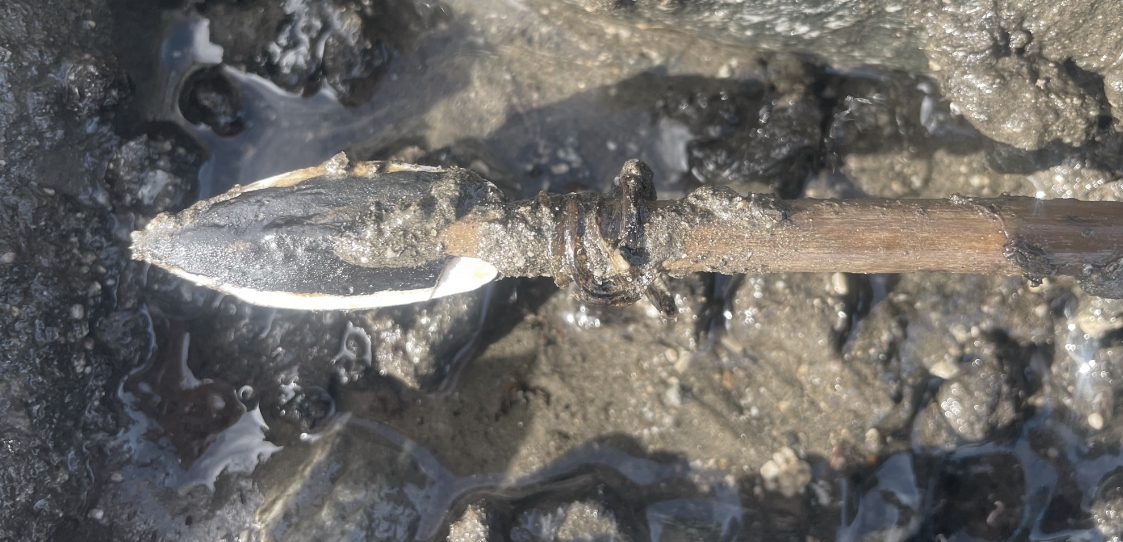














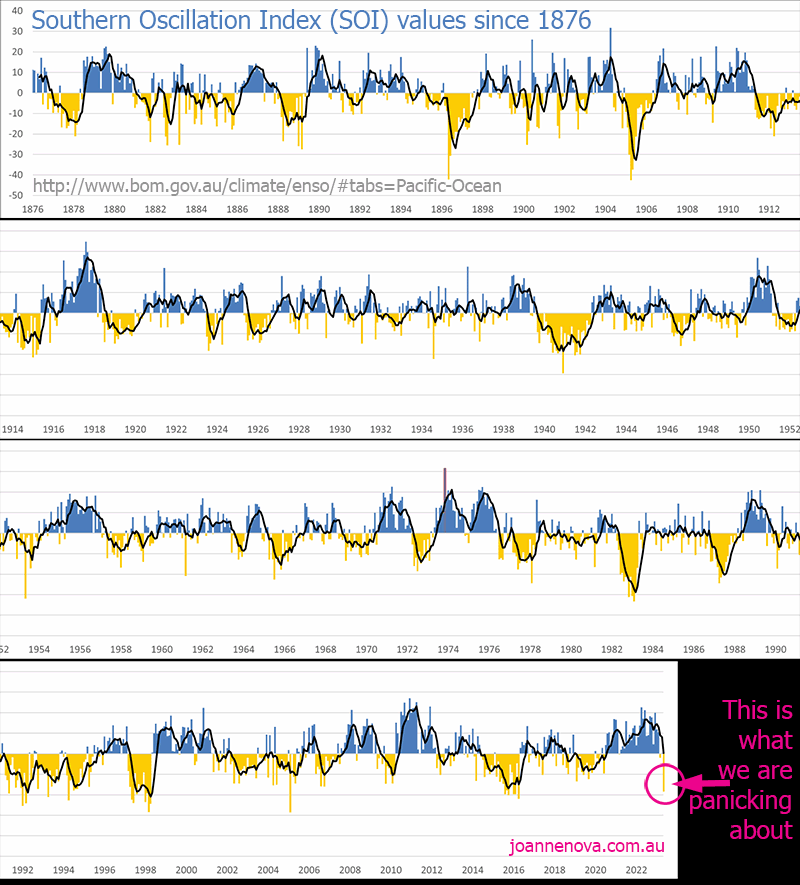




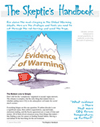






Recent Comments